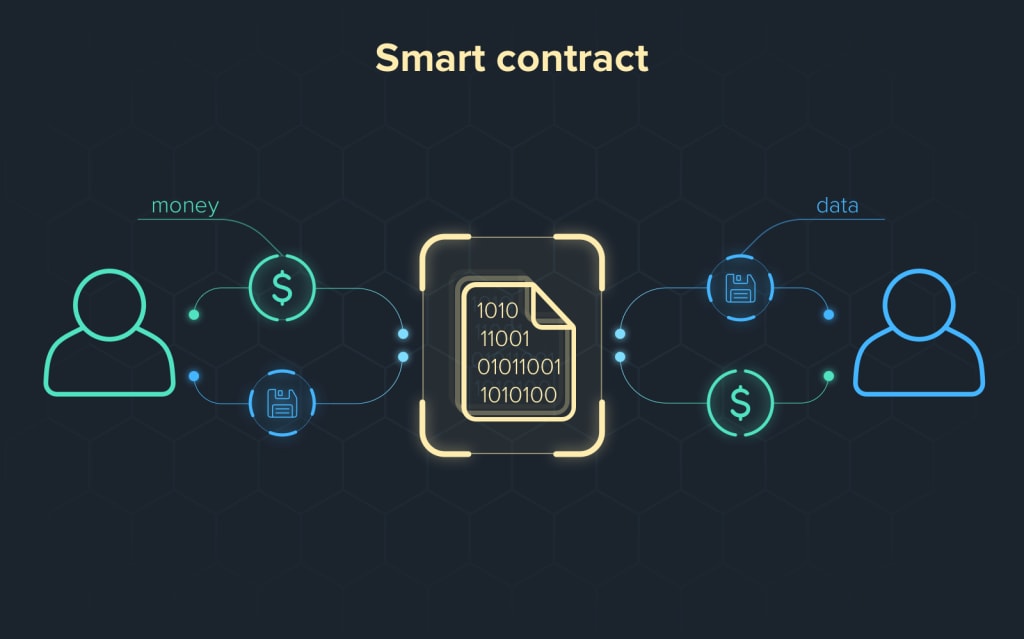Understanding Smart Contracts
A Simple Example in Solidity

Smart contracts are self-executing programs that can automate the exchange of assets between parties without the need for intermediaries. In this blog post, we will provide an introduction to smart contracts and demonstrate their functionality with a simple example program written in Solidity, a popular programming language for creating smart contracts on the Ethereum blockchain. We will cover the basics of Solidity syntax, the purpose of the example program, and how it can be deployed on the blockchain. By the end of this post, readers will have a basic understanding of smart contracts and be equipped to explore more complex use cases on their own.
Introduction
Smart contracts are a revolutionary technology that has the potential to transform the way we conduct business and exchange value. They are self-executing programs that can automate complex transactions without the need for intermediaries. In this blog post, we will provide a simple example of a smart contract written in Solidity, a popular programming language for creating smart contracts on the Ethereum blockchain. We will also explore the basics of Solidity syntax and the process of deploying a smart contract on the blockchain.
What are Smart Contracts?
Smart contracts are digital programs that can automatically execute the terms of a contract between two or more parties. They are stored on a blockchain and run on a decentralized network of computers, making them tamper-proof and transparent. Smart contracts are able to enforce rules and verify the outcome of a transaction, eliminating the need for intermediaries such as lawyers or banks.
Also Read: A Beginner’s Guide to Blockchain Technology: How to become blockchain expert from Blockchain Council
What is Solidity?
Solidity is a programming language used to write smart contracts on the Ethereum blockchain. It is a contract-oriented, high-level language that is similar to JavaScript and is designed to be secure and easy to use. Solidity allows developers to write complex smart contracts with functions that can be called by users, as well as variables that can store data on the blockchain.
Example Program:
Let’s look at a simple example program in Solidity to better understand how smart contracts work. Our example program is called “TeckyBlockToken” and is an implementation of the ERC-20 token standard, which is a common standard used for creating tokens on the Ethereum blockchain.
// SPDX-License-Identifier: MIT
pragma solidity ^0.8.0;
contract TeckyBlockToken {
string public name;
string public symbol;
uint8 public decimals;
uint256 public totalSupply;
mapping (address => uint256) public balanceOf;
mapping (address => mapping (address => uint256)) public allowance;
event Transfer(address indexed from, address indexed to, uint256 value);
event Approval(address indexed owner, address indexed spender, uint256 value);
constructor(string memory _name, string memory _symbol, uint8 _decimals, uint256 _totalSupply) {
name = _name;
symbol = _symbol;
decimals = _decimals;
totalSupply = _totalSupply;
balanceOf[msg.sender] = _totalSupply;
emit Transfer(address(0), msg.sender, _totalSupply);
}
function transfer(address _to, uint256 _value) public returns (bool success) {
require(_to != address(0), "Invalid address");
require(balanceOf[msg.sender] >= _value, "Insufficient balance");
balanceOf[msg.sender] -= _value;
balanceOf[_to] += _value;
emit Transfer(msg.sender, _to, _value);
return true;
}
function approve(address _spender, uint256 _value) public returns (bool success) {
require(_spender != address(0), "Invalid address");
allowance[msg.sender][_spender] = _value;
emit Approval(msg.sender, _spender, _value);
return true;
}
function transferFrom(address _from, address _to, uint256 _value) public returns (bool success) {
require(_to != address(0), "Invalid address");
require(balanceOf[_from] >= _value, "Insufficient balance");
require(allowance[_from][msg.sender] >= _value, "Not authorized");
balanceOf[_from] -= _value;
balanceOf[_to] += _value;
allowance[_from][msg.sender] -= _value;
emit Transfer(_from, _to, _value);
return true;
}
}
This program creates a token called “TeckyBlockToken”
Also Read: What technologies are used in blockchain?
First, we define the Solidity version that we are using with the statement pragma solidity ^0.8.0;. This ensures that the code is compiled with the appropriate version of Solidity.
We then define our contract with the contract keyword and give it a name. In this case, our contract is called TeckyBlockToken.
Next, we define several variables that will be used throughout the contract:
- name: A string that represents the name of the token.
- symbol: A string that represents the token symbol.
- decimals: An integer that represents the number of decimal places the token can be divided into.
- totalSupply: An integer that represents the total supply of tokens that will be created.
We then define two mappings:
- balanceOf: A mapping that maps an address to a balance of tokens.
- allowance: A mapping that maps an address to another address with an approved amount of tokens.
Next, we define two events:
- Transfer: An event that is emitted when tokens are transferred from one address to another.
- Approval: An event that is emitted when an address approves another address to spend tokens on its behalf.
In the constructor function, we set the values of the name, symbol, decimals, and totalSupply variables. We also set the balance of the contract creator’s address to the totalSupply and emit a Transfer event to indicate that the tokens have been transferred to the creator’s address.
We then define three functions:
- transfer: A function that allows an address to transfer tokens to another address.
- approve: A function that allows an address to approve another address to spend tokens on its behalf.
- transferFrom: A function that allows an address to transfer tokens on behalf of another address.
In the transfer function, we first check if the recipient address is valid and if the sender has enough tokens to transfer. If both conditions are met, we subtract the amount of tokens to be transferred from the sender’s balance and add it to the recipient’s balance. We then emit a Transfer event to indicate that the tokens have been transferred.
In the approve function, we first check if the spender address is valid. If it is, we set the approved amount of tokens in the allowance mapping for the sender’s address and the spender’s address. We then emit an Approval event to indicate that the sender has approved the spender to spend the tokens on its behalf.
In the transferFrom function, we first check if the recipient address is valid, if the sender has enough tokens to transfer, and if the sender has been authorized to spend the tokens on behalf of the owner of the tokens. If all conditions are met, we subtract the amount of tokens to be transferred from the owner’s balance and add it to the recipient’s balance. We also subtract the amount of tokens from the authorized spender’s allowance. We then emit a Transfer event to indicate that the tokens have been transferred.
Finally, we return a boolean value of true in each of the three functions to indicate that the transaction was successful.
Conclusion:
This example program demonstrates the basic structure of a smart contract written in Solidity. By creating a token with functions that allow for transfers and approvals, we can see how smart contracts can be used to automate complex transactions without the need for intermediaries. As you continue to explore the world of smart contracts, it is important to keep in mind the security implications and best practices for creating secure smart contracts. It is also important to thoroughly test and audit smart contracts before deploying them on a live blockchain to minimize the risk of vulnerabilities or bugs.
In summary, smart contracts are self-executing contracts with the terms of the agreement between buyer and seller being directly written into lines of code. They can be used to automate complex transactions and remove the need for intermediaries, increasing efficiency and reducing costs. Solidity is one of the most popular programming languages for creating smart contracts on the Ethereum blockchain, and understanding its syntax and structure is essential for developing secure and functional contracts.
By following the steps outlined in this example program, you can create your own simple token smart contract and begin exploring the world of smart contracts. As you gain more experience and knowledge, you can continue to develop more complex and sophisticated contracts to meet the needs of various industries and use cases.
Originally published at https://teckyblock.com on March 28, 2023.
About the Creator
TeckyBlock
Learn about blockchain technology, cryptocurrency, NFT and metaverse in here. please visit https://teckyblock.com for further information.






Comments
There are no comments for this story
Be the first to respond and start the conversation.